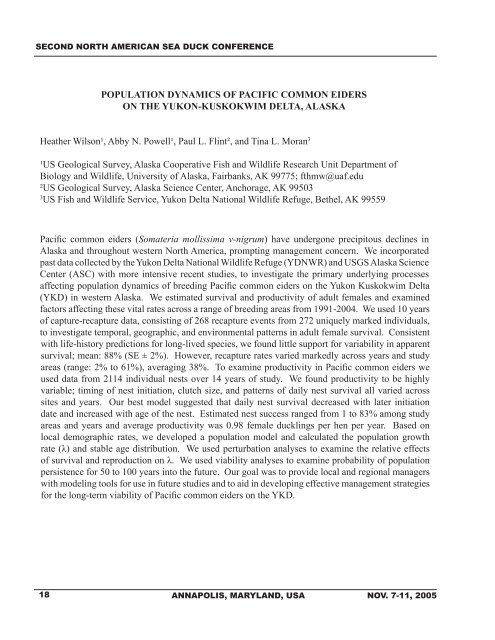Second North American Sea Duck Conference - Patuxent Wildlife ...
Second North American Sea Duck Conference - Patuxent Wildlife ...
Second North American Sea Duck Conference - Patuxent Wildlife ...
You also want an ePaper? Increase the reach of your titles
YUMPU automatically turns print PDFs into web optimized ePapers that Google loves.
SECOND NORTH AMERICAN SEA DUCK CONFERENCE<br />
POPULATION DYNAMICS OF PACIFIC COMMON EIDERS<br />
ON THE YUKON-KUSKOKWIM DELTA, ALASKA<br />
Heather Wilson¹, Abby N. Powell¹, Paul L. Flint², and Tina L. Moran 3<br />
¹US Geological Survey, Alaska Cooperative Fish and <strong>Wildlife</strong> Research Unit Department of<br />
Biology and <strong>Wildlife</strong>, University of Alaska, Fairbanks, AK 99775; fthmw@uaf.edu<br />
²US Geological Survey, Alaska Science Center, Anchorage, AK 99503<br />
3 US Fish and <strong>Wildlife</strong> Service, Yukon Delta National <strong>Wildlife</strong> Refuge, Bethel, AK 99559<br />
Pacific common eiders (Somateria mollissima v-nigrum) have undergone precipitous declines in<br />
Alaska and throughout western <strong>North</strong> America, prompting management concern. We incorporated<br />
past data collected by the Yukon Delta National <strong>Wildlife</strong> Refuge (YDNWR) and USGS Alaska Science<br />
Center (ASC) with more intensive recent studies, to investigate the primary underlying processes<br />
affecting population dynamics of breeding Pacific common eiders on the Yukon Kuskokwim Delta<br />
(YKD) in western Alaska. We estimated survival and productivity of adult females and examined<br />
factors affecting these vital rates across a range of breeding areas from 1991-2004. We used 10 years<br />
of capture-recapture data, consisting of 268 recapture events from 272 uniquely marked individuals,<br />
to investigate temporal, geographic, and environmental patterns in adult female survival. Consistent<br />
with life-history predictions for long-lived species, we found little support for variability in apparent<br />
survival; mean: 88% (SE ± 2%). However, recapture rates varied markedly across years and study<br />
areas (range: 2% to 61%), averaging 38%. To examine productivity in Pacific common eiders we<br />
used data from 2114 individual nests over 14 years of study. We found productivity to be highly<br />
variable; timing of nest initiation, clutch size, and patterns of daily nest survival all varied across<br />
sites and years. Our best model suggested that daily nest survival decreased with later initiation<br />
date and increased with age of the nest. Estimated nest success ranged from 1 to 83% among study<br />
areas and years and average productivity was 0.98 female ducklings per hen per year. Based on<br />
local demographic rates, we developed a population model and calculated the population growth<br />
rate (λ) and stable age distribution. We used perturbation analyses to examine the relative effects<br />
of survival and reproduction on λ. We used viability analyses to examine probability of population<br />
persistence for 50 to 100 years into the future. Our goal was to provide local and regional managers<br />
with modeling tools for use in future studies and to aid in developing effective management strategies<br />
for the long-term viability of Pacific common eiders on the YKD.<br />
18 ANNAPOLIS, MARYLAND, USA NOV. 7-11, 2005












